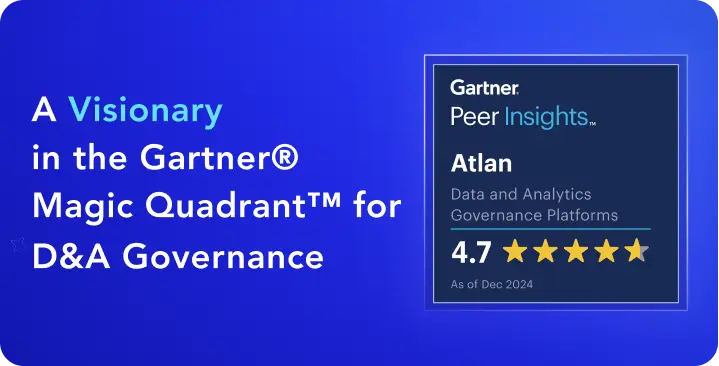How to Improve Data Governance? Steps, Tips & Template

Share this article
Improving data governance refers to the process of managing, protecting, and utilizing data in an organized, transparent, and responsible manner across an organization.
It entails establishing policies, procedures, and practices that ensure data is accurate, reliable, secure, and compliant with relevant regulations and standards.
And improving data governance is essential for organizations to maximize the value of their data, driving enhanced decision-making, operational efficiency, and competitive advantage.
In this article, we will explore the steps involved in improving and enhancing data governance, and tips to ensure its continuous improvement. We will also look into a template to assist your team in fostering a culture of continuous improvement for your data governance system.
Let’s dive in!
Table of contents #
- How to improve data governance?: 14 Strategic steps
- 10 Proven tips for ensuring continuous improvement of your data governance system
- Template to continuously improve your data governance
- Key takeaways
- Related reads
How to improve data governance: 14 strategic steps #
Enhancing data governance in your organization to track and curate access to data involves multiple steps, including establishing policies, building a governance framework, and leveraging the right tools. Here are some steps to consider:
- Develop a data governance strategy and policy
- Establish a data governance framework
- Understand and map your data landscape
- Establish a data governance committee
- Appoint a data governance lead or team
- Define data governance roles and responsibilities
- Leverage data governance tools
- Implement data classification and cataloging
- Create and enforce data access policies
- Implement data quality measures
- Implement data lineage and metadata management
- Conduct regular audits and reviews
- Train and educate employees
- Monitor and measure success
Now, let’s take a closer look at each of them and understand them in detail.
1. Develop a data governance strategy and policy #
Outline a clear data governance strategy that defines your organization’s goals and objectives and the scope of the governance program. Besides, create a data governance policy that outlines the rules and guidelines for data management, use, and protection within the organization. This policy should be clear, concise, and effectively communicated to all stakeholders in the organization.
2. Establish a data governance framework #
Before anything else, an organization needs to establish a robust data governance framework. This framework should detail the organizational structure, processes, and technology involved in data governance. This provides a blueprint for the management, use, and protection of data within the organization.
3. Understand and map your data landscape #
An organization should have a complete understanding of what data it has, where it is stored, how it flows within the organization, and who has access to it. This involves data inventory, data classification, and data flow mapping, which are crucial for managing data risks and complying with regulatory requirements.
4. Establish a data governance committee #
Create a cross-functional committee comprising representatives from key business units and departments. This committee should be responsible for overseeing the implementation of data governance policies, processes, and guidelines.
5. Appoint a data governance lead or team #
It’s important to have someone or a group of people in charge of data governance. This can be a Chief Data Officer, Data Governance Manager, or a cross-functional team dedicated to data governance. They will be responsible for spearheading the data governance initiatives and ensuring adherence to the set policies and practices.
6. Define data governance roles and responsibilities #
It’s important that everyone in the organization knows their role in data governance. This might involve data owners, data stewards, data users, and data custodians. Defining these roles clearly can help ensure accountability and facilitate better coordination in data management.
So, establish clear roles and responsibilities for data governance within the organization. This should include data owners, data stewards, and data users.
7. Leverage data governance tools #
There are many data governance tools and solutions available today that can help automate and streamline various aspects of data governance, including data quality management, data lineage tracking, and data cataloging. These tools can greatly enhance the efficiency and effectiveness of data governance.
These data governance tools and technologies can facilitate the tracking, management, and enforcement of data governance policies. So, look for tools that integrate with your existing systems and provide robust reporting capabilities.
8. Implement data classification and cataloging #
Develop a comprehensive data classification and cataloging process that identifies data sources, data types, and data owners. This will help in understanding the data landscape and in determining appropriate access controls.
9. Create and enforce data access policies #
Develop data access policies to control who can access data, what they can do with it, and how it can be used. Make sure these policies are well-documented and communicated throughout the organization.
10. Implement data quality measures #
Data quality is a key aspect of data governance. Poor data quality can lead to inaccurate insights and decision-making. Measures such as data validation, data cleaning, and data quality audits can help maintain high data quality.
11. Implement data lineage and metadata management #
Implement data lineage tracking and metadata management solutions to help maintain a complete understanding of data origins, transformations, and usage.
12. Conduct regular audits and reviews #
Regularly audit and review data governance processes to ensure compliance with internal policies and external regulations. Identify areas for improvement and address any gaps or inconsistencies.
13. Train and educate employees #
A successful data governance program requires the involvement and buy-in from all employees. Training and education on the importance of data governance and the organization’s specific policies and procedures can help achieve this. Encourage a data-driven culture that values data quality and proper data management.
14. Monitor and measure success #
Establish key performance indicators (KPIs) to measure the success of your data governance program. Regularly review these KPIs and make adjustments as needed to ensure continuous improvement.
By implementing these steps, you can improve data governance in your organization, ensuring that access to data is tracked and curated effectively while maintaining compliance with internal and external regulations.
Now, imagine that you have implemented data governance through your preferred platform. Now, what should you do to make it more efficient, effective, and valuable for the business?
Not sure about it? Let’s figure that out!
10 Proven tips for ensuring continuous improvement of your data governance system #
In order to ensure continuous improvement of your data governance system, you should focus on regular evaluation, monitoring, and adaptation. And here are the steps you need to follow:
- Set key performance indicators (KPIs)
- Monitor and track KPIs
- Establish feedback loops
- Conduct periodic audits and reviews
- Identify and prioritize improvement initiatives
- Implement improvements and measure the impact
- Promote a culture of continuous improvement
- Stay up-to-date with industry trends and best practices
- Provide ongoing training and education
- Review and update the data governance strategy
Now, we’ll examine each of them closely to gain a good understanding.
1. Set key performance indicators (KPIs) #
Define KPIs that measure the effectiveness and efficiency of your data governance system. These KPIs should be aligned with your organization’s strategic objectives and provide a clear view of the system’s performance.
2. Monitor and track KPIs #
Regularly monitor and track the KPIs to identify trends, patterns, and areas that require improvement. Use visualization tools to present data in a clear and concise manner, making it easy for stakeholders to understand the performance of the system.
3. Establish feedback loops #
Create channels for feedback from data users, data stewards, and other stakeholders. Encourage open communication and collaboration to identify areas that need improvement or optimization.
4. Conduct periodic audits and reviews #
Regularly audit and review the data governance system to ensure compliance with internal policies and external regulations. This will also help identify gaps, inconsistencies, or inefficiencies that need to be addressed.
5. Identify and prioritize improvement initiatives #
Based on the KPIs, feedback, and audit findings, identify improvement initiatives and prioritize them according to their potential impact on the business. This could include process optimization, policy refinement, or technology upgrades.
6. Implement improvements and measure the impact #
Implement the prioritized improvement initiatives and measure their impact on the KPIs. Assess the results to determine the effectiveness of the changes and make any necessary adjustments.
7. Promote a culture of continuous improvement #
Foster a culture that values data quality, accuracy, and governance. Encourage employees to actively participate in the continuous improvement process by identifying and sharing best practices, lessons learned, and innovative ideas.
8. Stay up-to-date with industry trends and best practices #
Regularly research and stay informed about emerging trends, best practices, and technologies in data governance. Evaluate their relevance to your organization and consider adopting or adapting them as needed.
9. Provide ongoing training and education #
Offer continuous training and education opportunities to employees to keep them informed about the latest data governance practices and tools. This will help ensure that your organization stays competitive and can adapt to changes in the business environment.
10. Review and update the data governance strategy #
Periodically review and update the data governance strategy to ensure it remains aligned with your organization’s strategic objectives and the evolving business landscape.
By focusing on these steps, you can ensure the continuous improvement of your data governance system, making it more efficient, effective, and valuable for your business. All right. Now, you know the steps to improve data governance, and tips to keep on improving it.
Now, wouldn’t it be great if you take away a template that tells you how to about enhancing data governance in your organization? Let’s get to it!
A must-have template to continuously improve your data governance #
This template will guide your team in establishing effective systems that promote a culture of continuous improvement for your data governance system, ensuring robust and dynamic data management practices within your organization.
Without any further ado, let’s explore what the template entails:
- Objectives and goals
- Key performance indicators (KPIs)
- Monitoring and reporting
- Feedback channels
- Periodic audits and reviews
- Improvement initiatives
- Training and education
- Communication and collaboration
- Industry trends and best practices
- Strategy review and update
Now, let’s unpack the details of each of them sequentially.
1. Objectives and goals #
Clearly state the objectives and goals of your data governance system. This should align with your organization’s strategic objectives and provide a clear vision for your team.
2. Key performance indicators (KPIs) #
List the KPIs that will be used to measure the effectiveness and efficiency of the data governance system. Define the metrics, targets, and data sources for each KPI.
3. Monitoring and reporting #
Outline the process for monitoring and reporting the KPIs. This should include the frequency of reporting, the responsible parties, and the tools used for visualization and analysis.
4. Feedback channels #
Describe the channels for collecting feedback from data users, data stewards, and other stakeholders. This may include regular meetings, surveys, or online collaboration tools.
5. Periodic audits and reviews #
Detail the schedule and process for conducting periodic audits and reviews of the data governance system. This should include the scope, responsible parties, and any external resources or consultants.
6. Improvement initiatives #
Provide a framework for identifying, prioritizing, and implementing improvement initiatives. This may include a process for submitting ideas, evaluating their potential impact, and assigning resources for implementation.
7. Training and education #
Outline the plan for providing ongoing training and education opportunities to employees. This should include the topics covered, the frequency of training sessions, and the responsible parties.
8. Communication and collaboration #
Describe the strategies for promoting open communication and collaboration among team members. This may include regular team meetings, knowledge-sharing platforms, or cross-functional working groups.
9. Industry trends and best practices #
Establish a process for staying informed about emerging trends, best practices, and technologies in data governance. This may involve subscribing to industry publications, attending conferences, or participating in professional organizations.
10. Strategy review and update #
Define the schedule and process for reviewing and updating the data governance strategy. This should include the responsible parties and the criteria for evaluating the need for changes or updates.
By following this template, you can create a structured approach to fostering a culture of continuous improvement for your data governance system. Customize the template as needed to suit the specific needs and context of your organization.
Key takeaways #
In a nugget, data governance is essential for organizations to maximize the value of their data, and gain a competitive edge in today’s data-driven landscape. Let’s recap and get a quick overview of what we’ve learned so far!
- Develop a data governance strategy, establish a cross-functional committee, and define roles and responsibilities.
- Implement data classification, cataloging, access policies, data lineage tracking, and metadata management.
- Leverage data governance tools and conduct regular audits and reviews.
- Provide training and education to employees and monitor the success of your data governance program.
For continuous improvement:
- Set and monitor KPIs to measure the effectiveness and efficiency of your data governance system.
- Establish feedback loops, conduct periodic audits, and identify and prioritize improvement initiatives.
- Implement improvements, measure their impact, and promote a culture of continuous improvement.
- Stay up-to-date with industry trends and best practices and provide ongoing training and education to employees.
- Review and update the data governance strategy as needed.
Lastly, we provided a template to help you foster a culture of continuous improvement within your data governance system. This template includes sections on objectives, KPIs, monitoring, feedback, audits, improvement initiatives, training, communication, industry trends, and strategy review.
And if you are looking to build or evaluate a modern data dictionary, take Atlan for a spin. Atlan is more than a standard data dictionary. It’s a third-generation modern data catalog built on the framework of embedded collaboration, borrowing principles from GitHub, Figma, Slack, Notion, Superhuman, and other modern tools that are commonplace today.
Data governance: Related reads #
- Automated Data Governance: How Does It Help You Manage Access, Security & More at Scale?
- Key Objectives of Data Governance: How Should You Think About Them?
- 7 Best Practices for Data Governance to Follow in 2023
- Data Governance and Compliance: Act of Checks & Balances
- Data Catalog: Does Your Business Really Need One?
Share this article












